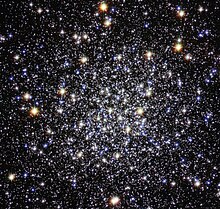Messier 12
|
Globular cluster Messier 12 |
|
|---|---|

|
|
| Panoramic shot | |
| AladinLite | |
| Constellation | Snake bearer |
|
Position equinox : J2000.0 , epoch : J2000.0 |
|
| Right ascension | 16 h 47 m 14.5 s |
| declination | −01 ° 56 ′ 52 ″ |
| Appearance | |
| Concentration class | IX |
| Brightness (visual) | 6.1 mag |
| Angular expansion | 16 ′ |
|
Color excess E (BV) (redness) |
0.17 |
| Physical data | |
| Affiliation | Milky Way |
| Integrated spectral type | F8 |
| Redshift | (−145 ± 2) ∙ 10 −6 |
| Radial velocity | (−43.5 ± 0.6) km / s |
| distance | 16 kLj (4.9 kpc ) |
| Absolute brightness | −7.5 mag |
| diameter | 75 years |
| Concentration lg (r t / r c ) | 1.38 |
| Metallicity [Fe / H] | −1.48 |
| history | |
| discovery | Charles Messier |
| Discovery date | May 30, 1764 |
| Catalog names | |
| M 12 • NGC 6218 • C 1644-018 • GCl 46 • | |
Messier 12 or M12 (also known as NGC 6218 ) is a 6.1 mag bright globular cluster with a diameter of 16 ′ in the constellation of the Serpent Bearer (Ophiuchus). Of the 5 globular clusters in the constellation (M9, 10, 12, 14 and 107), it is the brightest.
It was discovered by the French astronomer Charles Messier on May 30, 1764 - one day after its "twin", the M10 located 3 ° southeast. But it was not until 1783 that Wilhelm Herschel was able to break it down into individual stars. His son John recognized its richness, A. Smyth a bright star ring around the center and Lord Rosse around 1850 an indicated spiral structure .
With about 250,000 solar masses , M12 is one of the larger globular clusters and belongs to the inner galactic halo, from which it is never more than 20,000 light years away in an orbital period of 130 million years.
In 10 x 50 binoculars you can see a small, blurred disc, similar to the neighboring and spatially close pebble cluster Messier 10 . But in a telescope with a 10–15 cm aperture, its center appears more diffuse than in the M10, which is roughly the same old, and the bright single stars from 12th size onwards, which are easily recognizable in the six- to eight-inch model, are more loosely structured.
The wide center measures 2½ ', some star chains reach up to 10' in diameter, which has recently been estimated to be 30 'up to the limit size 20 mag. Among the only five variables are two RR Lyrae dwarfs and a Cepheid .
It is believed that the globular cluster lost around one million stars during one or more passages through the Milky Way due to tidal forces , which is around four fifths of its original mass.

literature
- Ronald Stoyan : Atlas of the Messier Objects - The Highlights of the Deep Sky , p.92-93. Oculum-Verlag, Erlangen 2006
- Bernd Koch, Stefan Korth: The Messier Objects - The 110 classic goals for sky observers . S. 32/33, Kosmos-Verlag, Stuttgart 2010
Web links
Individual evidence
- ↑ NASA / IPAC EXTRAGALACTIC DATABASE
- ↑ Harlow Shapley, Helen B. Sawyer: A Classification of Globular Clusters . In: Harvard College Observatory Bulletin . tape 849 , 1927, pp. 11-14 , bibcode : 1927BHarO.849 ... 11S .
- ↑ SEDS : NGC 6218
- ↑ a b Messier 12 at SEDS
- ↑ Seligman

